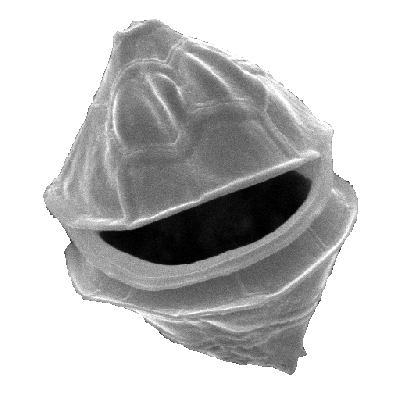The term Palynology, like "calcareous nannofossils", is a cover-all informal classification. It includes a large range of both extinct and extant organisms, the unifying character which allows us to "group" them together as palynomorphs is the composition of the preserved remains. This is usually an extremely tough, inert organic material called sporopollenin, although sometimes it may be chitin or pseudochitin. It must be remembered, however, that the preservation of all palynomorphs depends on the diagenetic processes they are subjected to. Palynomorphs are particularly susceptible to degradation by oxidising agents. The term palynology is derived from the Greek for sprinkle, and was suggested by Hyde and Williams in 1944. Palynomorphs generaly fall into one of nine groups:
- Cryptarchs, a rather outdated term for a group of Pre-Cambrian spherical forms of uncertain affinity or origin.
- Acritarchs, an artificial group, coined by Evitt in 1963, (the name means "of uncertain origin") includes any small, organic walled microfossil which cannot be assigned to a particular group. They are characterised by varied sculpture, some being spiny and others smooth. They are believed to have algal affinities, probably being the cysts of planktonic eukaryotic algae. They are valuable Palaeozoic biostratigraphic and palaeoenvironmental tools.
- Chitinozoa, are large (50-2000 microns in length) flask shaped palynomorphs which appear dark and almost opaque when viewed using a light microscope. They are important Palaeozoic microfossils.
- Scolecodonts are the mouth parts of annelid worms they are composed of chitin and silica, the chitin being carbonised to jet black during fossilisation; they are of limited stratigraphic use.
- Green and blue-green algae, is another catch-all grouping which includes two important freshwater forms: Botryococcus and Pediastrum. It also encompasses the prasinophycean algae which include the widespread and seemingly environmentaly tolerant genera Tasmanites, Pterospermella and Cymatiosphaera. The Zygnemataceae are another long ranging (Carboniferous to Recent) freshwater algal group which usually occur in shallow oxygen-rich water.
- Spores and pollen, derived from terrestrial plants, are probably the most widespread and important palynomorphs. Because of the ease with which they are transported by wind and water they can be found in almost all environments and sedimentary deposits. Spores first appear towards the end of the Silurian (coincident with the first land ferns) and continue to the present, they are stratigraphicly important. Pollen first appears in the Carboniferous (coincident with the first gymnosperms, including conifers), they typically have a bisaccate form. The evolution of the flowering plants (angiosperms) in the Cretaceous brought further developments in pollen form.
- Dinoflagellates are unicellular microplankton, they are commonly autotrophs but heterotrophic forms also occur, today they are second only to diatoms as marine primary producers. Dinoflagellates have a complex life cycle which includes a resting cyst stage, it is this cyst which is preserved (correctly termed a dinocyst). They are extremely important biostratigraphic and palaeoenvironmental tools especially in the Mesozoic and Cenozoic. They are composed of dinosporin, similar to sporopollenin but peculiar to dinoflagellates. The name derives from the Greek "dinos" meaning whirling and refers to the characteristic flagella, which propels them in a spiral motion.
- Fungal bodies are present in many palynological preparations, and appear as smooth, medium brown, rather simple bodies. They range from the Pre-Cambrian to the present so are of limited use stratigraphically.
- Foraminiferal test linings are common in palynology preparations from marine samples, but because they cannot be assigned to particular genera they are of little use although they have been used for palaeoenvironmental interpretations.
|




























